Using “JAGGU DADA” can take you to Courts now!

Introduction
There is a saying that “coming events cast their shadows before” and there was a premonition that it was not the last when Anil Kapoor sought protection of his IP and Personality Rights. Following the footsteps of his fellow actor in securing his IP rights, cine star Jackie Shroff has recently filed a suit against perpetrators for infringing his IP and Personality Rights wherein once again, the Hon’ble Delhi High Court recently in the case of Jaikishan Kakubhai Saraf Alias Jackie Shroff v. The Peppy Store & Ors, [1]has restrained the Defendants from infringing the actor’s personality rights.
What are Personality Rights?
The concept of personality rights encompasses the right of a person to regulate and control the unauthorized use of their personality attributes such as name, image, voice, likeness, etc.[2]
In the absence of a specific law, the Courts rely on precedents and judicial interpretations when protecting the rights of celebrities. The 1995 case of R.Rajagopal v. State of Tamil Nadu[3], also known as the Auto Shankar case, is one of the early cases that recognized the rights entrusted in personality rights. In this landmark case, the Hon’ble Supreme Court of India held that “the general law of privacy which affords a tort action for damages resulting from an unlawful invasion of privacy and the constitutional recognition given to the right to privacy which protects personal privacy against unlawful governmental invasion. The first aspect of this right must be said to have been violated where, for example, a person’s name or likeness is used, without his consent, for advertising or non-advertising purposes or for that matter, his life story is written whether laudatory or otherwise and published without his consent as explained hereinafter.”
In similar lines, the Hon’ble Delhi High Court in the case of Titan Industries Ltd. v. Ramkumar Jewellers[4], defined the term “celebrity” and held that a celebrity is “a famous or a well-known person and is merely a person who “many” people talk about or know about” while also opining that “the right to control commercial use of human identity is the right to publicity.”
In the very recent case of Jaikishan Kakubhai Saraf Alias Jackie Shroff v. The Peppy Store & Ors[5], the Plaintiff (Actor Jackie Shroff) filed a suit against the Defendants for violation of Personality Rights. Given the nature of the profession the Plaintiff contends that his personality, name, voice, image, likeness, mannerisms, gestures, and other uniquely identifiable characteristics associated with him and further contends that the Plaintiff exercises exclusive control over the above-mentioned attributes which constitute his ‘personality rights’ and ‘publicity rights.’
Furthermore, the Plaintiff claims to have obtained registrations for marks “BHIDU” and ‘Bhidu ka khopcha” under multiple classes and claimed that his personal name “JACKIE SHROFF” along with other names such as “Jackie”, “Jaggu Dada” and “Bhidu” are immediately and uniquely associated with him and no one else. The Plaintiff has filed the present suit against the Defendants (both identified and unidentified) for using allowing users to search and share GIF files exploiting the Plaintiff’s image, likeness and name, offering ringtones and wallpapers featuring Plaintiff’s image without authorization. It was also claimed by the Plaintiff that the compilation video of Plaintiff’s interview titled “Thug Life” portraying the Plaintiff with sunglasses/caps/cigarettes/gold chains other animated images/gifs along with other photo-shopped elements is derogatory and infringes personality rights of Plaintiff. Aggrieved by the acts of the Defendant the Plaintiff had filed the suit against them.
| Application Number | Class | Mark | Status |
| 3227968 | Class 25 (Ready-made garments, hosiery, articles of clothing shirts; jeans, cotton trouser, garments included in class25 | BHIDU | Registered |
| 3227969 | Class 41 (Entertainment, Education, Providing of Training, Film Production, Sporting And Cultural Activities, Playschool, Nursery And Kindergarten School, Event Organization And Management included in Class 41). | BHIDU | Registered |
| 4362494 | Class 41 (Education; Providing of Training; Entertainment; Sporting And Cultural Activities As Covered Under Class 41) | Bhidu ka khopcha | Registered |


Upholding the rights of the Plaintiff the Hon’ble Delhi High Court after examining the Defendant’s activities opined that “the activities of the Defendant constitute an infringement of personality rights of the Plaintiff and provides the general public with the impression that the Plaintiff is endorsing or indulged into activities promoted by the Defendants and passed an injunction order against the Defendants restraining them from using violating personality rights by utilizing/exploiting/misappropriating the Plaintiff’s name ‘JACKIE SHROFF” and other sobriquets including “JACKIE”, “JAGGU DADA”, voice; image; for any commercial purpose without the Plaintiff’s consent and/or authorization”.
However, the Hon’ble Court after examining the compilation interview video titled “Thug Life” on YouTube did not pass an injunction order against Defendant No. 5 and held that “the usage of the term ‘Thug Life’ is meant as a compliment and not a derogatory word and observed that the YouTube video compiles publicly available interview clips where Plaintiff is portrayed with forthrightness and wit” the Hon’ble Delhi High Court further opined that the “additions made by the Defendant No.5 such as the usage of Thug Life caption along with visual embellishments highlight the Plaintiff’s bold personality that aligns with the meme culture hence restricting such creative expressions by a way of blocking and removing videos on the internet can set a precedent that stifles freedom of expression”
As observed by the Hon’ble Delhi High Court in the case of Anil Kapoor v. Simply Life India & Ors[6], actor Anil Kapoor (Plaintiff) filed a suit against the Defendants for utilizing Deepfake Technology and Artificial Intelligence and representing Plaintiff as actresses in a derogatory and offensive manner, using Plaintiff’s generative Artificial Intelligence as a Disney Character, Morphing Plaintiff’s face and seeking payments from customers etc.,[7] The Hon’ble Delhi High Court took cognizance of the case and passed an ex-parte injunction order against the Defendant restraining them from using Plaintiff’s “name, likeness, image, voice, personality or any other aspects of his persona to create any merchandise, ringtones, ring back tones, or in any other manner misuse the said attributes using technological tools such as Artificial Intelligence, Machine Learning, deep fakes, face morphing, GIFs either for monetary gains or otherwise to create any videos, photographs, etc., for commercial purposes, so as to result in violation of the Plaintiff’s personality rights“.
Similarly in the case of Amitabh Bachchan v. Rajat Nagi & Ors.,[8] the Hon’ble Delhi High Court passed an omnibus interim injunction order restraining the Defendants at large from infringing the personality and publicity rights of Plaintiff by misusing his name ‘Amitabh Bachchan’/ ‘bachchan’/AB/BigB’, his voice, image or any other attribute which is exclusively identifiable with him for any commercial gains.
Yuvraj Singh invokes Arbitration clause to protect Personality Rights
Obtaining an injunction order against the miscreants from violating the personality rights is one handy option available to the celebrities for protecting their personality, however if there is a contract/agreement in place for exploiting these rights by third parties, then in that case, celebrities have the right to invoke the arbitration clause if a party continues to exploit the personality right after the expiry of such contract/agreement.
In a very recent case, former Indian Cricketer Yuvraj Singh has issued legal notice, invoking the Arbitration clause, against a Delhi based Real Estate firm for violation of his privacy, personality rights and misuse of Brand Value by using his photographs on billboards, project site, social media etc., for commercial purpose after the expiry of the MoU.[9]
Conclusion
Personality Rights have become an increasingly important issue in today’s world. Celebrities have become more vigilant and are trying to protect their personality rights like name, images, voice and likeness from being exploited by miscreants for commercial gains. While the courts have recognized the importance of protecting the personality rights of celebrities by establishing precedents, there is a need of statutory framework that address the issue at hand.
[1] CS(COMM) 389/2024
[3] 1994 SCC (6) 632
[4] CS(OS) No.2662/2011
[5] CS(COMM) 389/2024
[6] Anil Kapoor v. Simply Life India & Ors CS(COMM) 652/2023
[7] Para 29. Anil Kapoor v. Simply Life India & Ors CS(COMM) 652/2023
[8] CS(COMM) 819/2022
Phonetic Search: A Crucial Step in Safeguarding Your Trademark

Introduction
Imitation is the best form of flattery, yet there is a thick dividing line when it comes to using/copying a brand name. As known to all brand name serves as an identity of a product in as much similar to the name of a person and reflects all attributes of it. Adapting brand names of someone else without proper permission and authorization tantamount to malfeasance with the object of unjustified enhancement. Therefore in order to avoid such unwanted situations and conflict conducting a proper trademark search is necessary. While conducting a trademark search businesses need to look for trademarks that are similar in sound, appearance, or concept/ meaning to the intended mark.
Recently the Hon’ble Delhi High Court in the case of Institut Europeen D. Administration Des Affaires v. Fullstack Education (P) Ltd[1], highlighted the importance of conducting a proper word mark search and phonetic search at the preliminary stage.
Understanding Phonetic Similarity in Trademark Registration
Before registering a brand name as trademark conducting a proper trade mark search is necessary. One important aspect of trademark search is evaluating the phonetic similarity that might exist between the intended mark and existing trademarks out there in the market. Phonetic similarity refers to the comparable nature of how two or more trademarks are pronounced. Phonetic search in general involves analyzing the sound/ pronounciation of a word rather than its spelling. This is particularly significant in languages such as English, where the relationship between sound and spelling can be complex and nuanced. The English language, for instance, is known for its numerous homophones ,i.e.,words that are pronounced similarly but have different meanings and different spellings. For example words like ‘Night’ and ‘Knight’ are pronounced in the same way but have different spellings and convey two distinct meaning.[2]
Phonetically similar names can create “brand confusion” significantly impacting the manner how consumers associate and remember brands, potentially allowing a lesser-known mark to unfairly benefit from the reputation of a comparatively more established one.
Hence conducting a Phonetic search in the trademark registration process enhances the overall protection of intellectual property rights, minimizes the risk of infringement and strengthens the brand identity by ensuring that trademarks are not only directly but phonetically distinctive as well.
Statutory Provisions Recognizing the Concept of Phonetic Similarity
The Trade Marks Act, 1999 under Section 29(9) states that “where the distinctive elements of a registered trade mark consist of or include words, the trade mark may be infringed by the spoken use of those words as well as by their visual representation and reference in this section to the use of a mark shall be construed accordingly”. This provision stipulates that a registered trademark can be infringed not only by the visual representation of the mark, but also by its spoken or phonetic use.
The Hon’ble courts in plethora of cases have emphasized the importance of considering both the phonetic and visual similarities between trademarks when assessing the potential infringement..[3]
The importance of the phonetic search can be ascertained from the recent case of Institut Europeen D. Administration Des Affaires v. Fullstack Education (P) Ltd.[4], wherein the Hon’ble Delhi High Court has directed the Trade Marks Registry to conduct a phonetic search of a trademark even at the preliminary stage of the application process itself. In this case the Petitioner and the Respondent were engaged in the business of providing educational services and used the mark  and
and  respectively. The Petitioner contended that its mark
respectively. The Petitioner contended that its mark  was founded in the year 1957 and claimed to have obtained registrations for the word mark INSEAD (Institut Europeen D Administration Des Affaires Association) and device mark
was founded in the year 1957 and claimed to have obtained registrations for the word mark INSEAD (Institut Europeen D Administration Des Affaires Association) and device mark  in classes 41, 35 and 16 on a “proposed to be used basis”. The Petitioner contended that the Respondent use of the mark INSAID (International School of AI and Data Science) was deceptively and phonetically similar to that of the Petitioner mark. The Petitioner further claimed that the use of the mark INSAID by the Respondent had created confusion amongst the students of the Petitioner. Taking cognizance of the case the Hon’ble Delhi High Court in order to determine the Phonetic Similarity in the case applied the classical test which was postulated in Pianotist Co.’s Application, Re, (1906) 23 RPC 774, wherein it was held: “You must take the two words. You must judge them, both by their look and by their sound. You consider the goods to which they were to be applied. You must consider the nature and kind of customer who would be likely to buy those goods. In fact, you must consider all the surrounding circumstances; and you must further consider what was likely to happen if each of those trade marks was used in a normal way as a trade mark for the goods of the respective owners of the marks”[5]
in classes 41, 35 and 16 on a “proposed to be used basis”. The Petitioner contended that the Respondent use of the mark INSAID (International School of AI and Data Science) was deceptively and phonetically similar to that of the Petitioner mark. The Petitioner further claimed that the use of the mark INSAID by the Respondent had created confusion amongst the students of the Petitioner. Taking cognizance of the case the Hon’ble Delhi High Court in order to determine the Phonetic Similarity in the case applied the classical test which was postulated in Pianotist Co.’s Application, Re, (1906) 23 RPC 774, wherein it was held: “You must take the two words. You must judge them, both by their look and by their sound. You consider the goods to which they were to be applied. You must consider the nature and kind of customer who would be likely to buy those goods. In fact, you must consider all the surrounding circumstances; and you must further consider what was likely to happen if each of those trade marks was used in a normal way as a trade mark for the goods of the respective owners of the marks”[5]
After applying the test the court opined that the marks of Petitioner and Respondent are phonetically and confusingly similar. The court further held that “Petitioner is the prior registered user of the mark INSEAD and its device mark  under class in class 16, 35 and 41 since 2007 and 21012 respectively and held that the use of the acronym INSAID by the Respondent which was phonetically similar to the acronym used by the Petitioner is confusingly similar and therefore cannot be said to be used in good faith and thereby set aside the registration of the Respondent mark INSAID.
under class in class 16, 35 and 41 since 2007 and 21012 respectively and held that the use of the acronym INSAID by the Respondent which was phonetically similar to the acronym used by the Petitioner is confusingly similar and therefore cannot be said to be used in good faith and thereby set aside the registration of the Respondent mark INSAID.
This ruling by the Hon’ble High Court of Delhi reflects the importance of thorough trademark searches to prevent confusion and infringement in the marketplace highlighting the critical role of phonetic similarity in ensuring the distinctiveness and protectability of trademarks.In similar lines the Hon’ble Delhi High Court in the case of M/S Lakme Ltd. v. M/S Subhash Trading[6], established that the brand names “Lakme” and “LikeMe” bore significant resemblance. Despite the difference in their spellings, the court concluded that the phonetic similarity between the two marks can potentially mislead and confuse consumers regarding the plaintiff’s products.
In another case of Encore Electronics Ltd. v. Anchor Electricals & Electronics Pvt. Ltd.[7], wherein the marks in question were ‘ENCORE’ and ‘ANCHOR’, the Hon’ble Bombay High Court held that even though the two words are pronounced differently in the countries of their origin, the pronunciation of two words is similar in India, therefore the marks will be considered phonetically similar.
In the case of Consitex SA v. Kamini Jain and Ors.[8], wherein the dispute was between the marks, ‘ZEGNA’ (pronounced as ‘Zen-Yah’) associated with an Italian luxury fashion brand, and an India brand ‘JENYA’, the Hon’ble Delhi High Court ruled in favour of the plaintiff, emphasizing that these two marks were phonetically similar as the plaintiff was able to provide documents demonstrating that ‘ZEGNA’ is pronounced as ‘Zen-Yah’.
Conclusion
It is inferred from the above that conducting a thorough phonetic search is essential prior to initiating the trademark registration process. Understanding the impact of phonetic similarity on brand recognition and consumer perception is crucial for protecting intellectual property rights and to avoid legal conflicts at the time of objection by the Trademark registry as well as opposition by a third party. By recognizing the significance of trademark phonetic search = businesses can ensure that their trademarks are both visually distinct and phonetically unique which will save time and resource and subsequently result as a cost effective step as the same will help in avoiding the statutory delays. There are high chances that a unique trademark will smoothly pass the stages of trademark objection and trademark opposition.
[1] C.O. (COMM.IPD-TM) 1/2021
[2] https://www.tramatm.com/trademark-dictionary/phonetic-similarity
[4] C.O. (COMM.IPD-TM) 1/2021
[6] 1996 PTC (16)567
[7] 2007 SCC Online Bom 147
[8] CS (OS) No. 629/2011
Madras High Court Orders Reconstitution of Patent Opposition Board in Tata Motors vs Ashok Leyland Case

INTRODUCTION
Recently, in Ashok Leyland Limited v. The Controller of Patents & Designs and others[1], the Division Bench of Hon’ble Madras High Court vide its order dated April 10, 2024, allowed the writ appeal and set aside the order passed in Writ Petition by the single judge in respect of the post-grant opposition proceedings against the patent granted to the Ashok Leyland Ltd. The Division Bench directed the patent office to reconstitute another Opposition Board to examine the matter afresh by considering the evidence submitted by the Ashok Leyland Ltd. and the Tata Motors. However, the Court refrained from reviewing the procedure adopted by the Opposition Board for examination and submission of its recommendations, as the procedure is expressly laid down in the Patents Act and the Rules.
BACKGROUND, FACTS AND ARGUMENTS SUBMITTED (in Writ Petition)
In the instant case, a patent vide Patent No. IN387429 was granted to Ashok Leyland Limited (hereinafter referred to as “appellant”) in respect of the patent Application No. 201641025668 titled “Multi-Axle Vehicle Configuration having Heavy Duty Lift Axle”, and the same was opposed by the opponent Tata Motors Ltd. (hereinafter referred to as “Respondent No. 2”) by way of post-grant opposition on the grounds of prior publication, public use, non-patentable subject matter, obviousness, and insufficiency of disclosure under Section 25(2) of the Patents Act. After receiving the said application, the Controller of Patents & Designs (hereinafter referred to as “Respondent No. 1), an Opposition Board (hereinafter referred to as “Board”) was constituted under Section 25(3) of the Patents Act. During the opposition proceedings, documents including written submissions, reply statement, and affidavits of technical experts (evidence) from both sides were submitted before Respondent No. 1. The Board submitted its recommendations (hereinafter referred to as “report”) to Respondent No. 1 on October 31, 2023. During the pendency of the opposition proceedings, the appellant filed a writ petition before the Intellectual Property Division of the Hon’ble Madras High Court (hereinafter referred to as “IPD) seeking relief in terms of challenging the report of the Board, assailing the procedure adopted by the Board by submitting praying that the expert evidence was not considered during examination and submission of the report.
The appellant prayed to quash the report of the Board and requested the IPD to direct Respondent No. 1 to reconstitute a fresh Opposition Board as the Board failed to consider the evidence submitted by both parties while preparing the report and it merely cut-copied-pasted the portions from the written submissions and the reply statement of the appellant and the Respondent No. 2 respectively. The appellant relied on CIPLA Ltd. v. Union of India and others[2], where the Hon’ble Supreme Court recognized the significance of evidence submitted by the parties during opposition proceedings.
However, Respondent No. 2 argued that the Board has duly considered the evidence without making any such reference in the report, as out of five grounds only one ground was considered by the Board in the report that deprives any possibility of non-applicability of mind in preparation of the report. Further, Respondent No. 2 also argued that the report of the Board is not binding on Respondent No. 1 since it has only a recommendatory value.
The IPD dismissed the petition by stating that due to the recommendatory nature of the report, the recommendations of the Opposition Board is not binding on the Controller.[3] However, the IPD also held that if the Controller during the final hearing found that the Opposition Board had failed to consider the evidence of the experts, then the Controller can reconstitute the Opposition Board to present fresh recommendations by considering the evidence document. Aggrieved by the dismissal of the writ petition, the appellant filed an appeal to the Division Bench of Hon’ble Madras High Court against the order dated March 15, 2024, of the IPD.
COURT DECISION
After considering all the facts, findings, and arguments of the appellant and the respondents submitted during the hearing before the IPD, the Division Bench set aside the order of the IPD. The Division Bench directed Respondent No. 1 to reconstitute the Board and the Board shall consider the evidence and documents as mentioned in Rule 56(4) while conducting a de novo examination to submit afresh recommendations in accordance with Sections 25(2) & 25(3) of the Patents Act by May 22, 2024.
The Division Bench observed that the procedure adopted by the Opposition Board in preparing the report and the correctness thereof cannot be left to the Controller in the final hearing stage. The Court mentioned that the Board must submit recommendations with reasons on each ground after examining and evaluating the documents including evidence under Rule 56(4) of the Patents Rules. It was held that the recommendations of the Board are important in deciding the validity of the patent document on the grounds raised by the opponent. Therefore, it is desirable to reconstitute the Board to provide fresh recommendations by considering the evidence documents submitted by parties.
However, the Bench denied any judicial review of the procedure adopted by the Opposition Board, and held that “We make it clear that the impugned order is set aside for the purpose of facilitating de novo drill by the Board to be reconstituted by said Controller and on merits we have expressed only one view and that view pertains to paragraph 5 of the impugned order wherein we have said that this Court is not denuded of constitutional powers of judicial review qua recommendation of said Board or the procedure to be followed by said Board”.
ANALYSIS
Section 25(3) requires the Controller to constitute an Opposition Board and refer notice of opposition and documents (as submitted by patentee and opponent) to the Board for further examination and submission of recommendations to the Controller under the prescribed procedure laid down under Rules 56 to 60 of the Patents Rules, 2003 (as amended). Since Rule 56(4) warrants the Opposition Board to examine the documents received by the Controller under prescribed rules, the Board is required to submit a report with reasons on each ground taken in the notice of opposition. Documents, as mentioned in the prescribed rules (Rules 57 to 60), include a written statement and evidence submitted by the opponent, a reply statement and evidence of the patentee, and any further evidence submitted by either party with the leave of the Controller.
The Opposition Board examines the notice of opposition on the grounds mentioned therein based on the documents including evidence submitted by the patentee and the opponent(s). The participating parties to the opposition proceedings rely on evidence to support or oppose the challenges raised against the grant of a patent under Section 25(2) of the Patents Act. It is understood that the post-grant opposition provides an opportunity to a person interested whose rights may get affected due to the grant of a patent, and it allows him to bring any residual issue(s) that were overlooked by the granting authority during the prosecution process.
What will happen if the grant of a patent by an official authority fully crystallizes a patentee’s rights against the whole world without thoroughly reviewing the documents submitted by the opponent and the patentee during the opposition proceedings? As Sir Edward Fry commented on the scope of opposition examination while presiding over the Patents Enquiry Committee: “We are of opinion that the grant of invalid patents is a serious evil inasmuch as it tends to the restraint of trade and to the embarrassment of honest traders and inventors.”[4], and the same was reiterated by the Hon’ble Supreme Court in Aloys Wobben v. Yogest Mehta[5] that the rights of a patent holder are not crystallised with the decision of Controller to grant a patent. It is only when challenges raised against the grant of a patent under Section 25(2) are disposed of favourably to the advantage of the patent holder, that the right to hold a patent is stated to have crystallised. Therefore, it is necessary to thoroughly scrutinize the grounds raised by the opponent and reply filed by the patentee in view of the evidence submitted by the parties so as to clearly identify the validity or invalidity of the granted patent. Without considering the submissions filed by the participating parties, it is unreasonable either to crystallize the rights of the patentee or allow the patent to be revoked. The recent decision of the Hon’ble Madras High Court indicates the importance of evidence while examining the opposition by the Opposition Board to determine the maintainability of the granted patents.
[1] 2024:MHC:1768 (W.A. No.1181 of 2024), Order passed by Division Bench of Madras High Court on April 10, 2024
[2] AIRONLINE 2012 SC 363
[3] (W.P.(IPD) No.1 of 2024) Order passed by IP Division of Madras High Court on March 15, 2024
[4] Page 80, Report on the revision of the Patents Law, September, 1959 (Ayyangar Committee report on Patents), Accessible at https://ipindia.gov.in/writereaddata/Portal/Images/pdf/1959-_Justice_N_R_Ayyangar_committee_report.pdf
[5] AIR 2014 SUPREME COURT 2210
Generative AI and Patent Monetization

Introduction
The intersection of generative artificial intelligence and patent monetization marks a transformative phase in the realm of intellectual property management. Generative AI, which utilizes the advanced algorithms to create new data and innovations from the existing information, has demonstrated significant potential in reshaping the various sectors, including technology, pharmaceuticals, automotive sector etc. When applied to patent monetization, generative AI can fundamentally transform how the patents are developed, evaluated and commercialized. The generative AI’s capabilities extend to analyzing the vast databases of existing trends, gaps and opportunities of innovation. This can lead to creation of new patentable innovations by suggesting novel improvements and variations on existing technologies. Additionally, generative AI can streamline the process of patent evaluation. The collaboration between the generative AI and patent monetization not only enhances the value extraction from the patent but also foster a more innovative and competitive market. This article explores the role of generative AI in patent pool are shaping the future of Intellectual Property (IP) monetization.
Role of Generative AI in Patent Monetization
Generative AI plays a pivotal role in the evolving field of patent monetization by revolutionizing how the patents are evaluated and commercialized. The following are the role of the generative AI in patent monetization:
- Streamlining the Searches for Right Patent: In the past, finding a relevant patent used to be slowand a tedious task as it involved spending hours analyzing large volume of documents, which could result in missing vital information or mistakes. The Generative AI is changing the game by using algorithms to quickly scan vast amount of databases in a flash. The generative AI is not only fast but it is also smart. It can also analyze the relevant patent applications, description and related technical studies.
- Enhanced Decision Making with Predictive Analysis: Predictive analysis (it is process of using data to forecast future outcomes) is a revolutionary application of generative AI in patent monetization. It allows the patent owners to make informed decision about which patents to license and which potential licensees to approach. Generative AI- driven predictive analysis can help in evaluating litigation risks, forecast financial returns from various monetization strategies and even recommend optimal pricing for licensing agreement. This provides for a more nuanced understanding of a patent’s true value, enabling patent holders to negotiate licensing deals with greater confidence.
- Predicting Future Trends: Generative AI can be used to forecast future market demands and technological advancement by analyzing the market trends and patent data. This enables the patent holders to align their strategies with anticipated industry development; ensuring they stay competitive and capitalize on emerging opportunities.
- Assisting IP Professionals: The Generative AI is a powerful tool that enhances the capabilities of the IP professionals. By automating the routine and time consuming task, generative AI allows the patent professionals, analysts etc. to concentrate on the strategic aspect of the patent monetization such as negotiation. The generative AI system can analyze the data relating to potential opportunities and upcoming trends. This ability enables the IP professionals to give more informed advice and identify potential monetization opportunities.
- Improved Pool Formation: AI can analyze patent landscape to identify complementary patents that would be well suited for inclusion in a pool, leading to stronger and more attractive offerings for potential licensees.
- Cost effective: Patent pool facilitates patent monetization by allowing the patent holder to have access to variety of patents from multiple patent holders, thereby reducing the transaction cost as they only need to enter into a single agreement rather than negotiating individuals agreements with each business and also minimizes the litigation cost associated with the infringement lawsuits.
Challenges
While the generative AI plays a significant role in patent monetization. It also introduces loopholes and challenges that must be addressed. The following are the challenges associated with the use of generative AI in patent monetization:
A. Data Bias: The effectiveness of generative AI model depends heavily on the quality of the data they are trained with. Biased databases can result in biased innovations, therefore it is important to mitigate data bias to maintain ethics in AI-driven innovation.
B. Continuous need for Human Expertise: While generative AI can offer valuable suggestions, however, human expertise remain indispensable while evaluating the feasibility and commercial potential of the AI-generated information.
Conclusion:
In conclusion, the generative AI and patent pooling represent the future of patent monetization. Generative AI assists in streamlining the identification, creation and optimization of patents, enabling more efficient and effective intellectual property management. This technology can analyze vast databases to identify valuable patent opportunities, predicting market trends, enhanced decision making etc. In terms of cost effectiveness, generative AI and patent pooling substantially lowers the financial cost for securing and defending patent infringement lawsuits. Pool members benefit from shared resources, such as access to different patents, administrative support, legal expertise etc. Moreover, by reducing the risk associated with patent infringement lawsuits, member to the patent pool substantially save money which would otherwise be spent on legal battles. However, challenges such as data bias and the continuous need for the human expertise showcases the importance of responsible and informed utilization of generative AI in patent monetization. Addressing these challenges and harnessing the capabilities of the generative AI effectively will make the patent landscape more accessible, equitable and conducive to technological advancement, ultimately leading to more effective and profitable patent monetization.
Related Articles of SS Rana:
https://ssrana.in/articles/generative-ai-an-eu-indian-perspective/
https://ssrana.in/articles/meity-approval-companies-ai-generative-models/
https://ssrana.in/articles/government-amend-it-act-introduce-rules-regulating-ai-companies-generative-ai-models/
https://ssrana.in/articles/navigating-innovation-the-ins-and-outs-of-patent-pools/
“NEW GROUNDBREAKING” WIPO Treaty on IP and Traditional Knowledge

The World Intellectual Property Organization (WIPO), on May 24, 2024, adopted the historic new treaty on Intellectual Property (IP), Genetic Resources and Traditional Knowledge[1]. The Treaty was adopted after 25 years of dialogue and negotiations taking place since 2001. This adopted treaty is not only the first of its kind that addresses the interface existing between IP, Genetic Resources, and Traditional Knowledge but also includes provisions that specifically deal with the traditional knowledge and genetic resources held by indigenous people as well as local communities.[2]
Highlights of WIPO Treaty on Intellectual Property (IP), Genetic Resources and Traditional Knowledge
- Objective
As enshrined under Article 1, the main objectives of the newly adopted treaty are to:- Enhance the efficacy, transparency, and quality of the patent system with respect to genetic resources and traditional knowledge associated with genetic resources, and
- prevent erroneous grant of patent protection to inventions that lack Novelty or inventive steps with respect to genetic resources and traditional knowledge associated with genetic resources.
- Disclosure Requirement for invention based on genetic resource and Traditional Knowledge
Article 3.1 of the Treaty states that where the claimed invention in a patent application is based on genetic resources, then each contracting parties should require applicants to disclose.- The country of origin of the genetic resources
- In case the applicant does not have information required under Article 3.1 (a) or Article 3.1(b) is not required, then the source of genetic resources is to be disclosed.
Article 3.2 of the Treaty provides that where the invention is based on traditional knowledge associated with genetic resources, then each contracting party should require applicants to disclose
- Indigenous people or local communities who provided such traditional knowledge associated with genetic resources
- In case the applicant does not have the information required under Article 3.2(a) or Article 3.2 (b) is not required, then the source of traditional knowledge associated with genetic resources is to be disclosed.
Moreover, Article 3.3 states that wherein no information under Article 3.1 and Article 3.2 is known to the applicant then the contracting parties shall require the applicant to make a declaration to that effect, affirming that the content of the declaration is true and correct to the best knowledge of the applicant.
- Sanctions and Remedies
Article 5.1 of the treaty states that each contracting party should put appropriate, effective, and proportionate legal, and administrative policy measures to address the failure to provide information by the applicant under Article 3. - Information Systems
Article 6.1 of the treaty states that Contracting Parties may establish information systems (such as databases) of genetic resources and traditional knowledge associated with genetic resources, in consultation, where applicable, with Indigenous Peoples local communities, and other stakeholders, taking into account their national circumstances.Article 6.2 of the treaty states that the contracting party should (with appropriate safeguards and consultations with the indigenous people, local communities, and stakeholders) make such information system accessible to Offices for Patent search and examination. - General Principles on Implementation
Article 9.1 states that Contracting Parties undertake to adopt the measures necessary to ensure the application of this Treaty.Article 9.2 provides that nothing shall prevent Contracting Parties from implementing the provisions of this Treaty within their legal systems and practices. - Entry in Force
Article 17 states that the newly adopted Treaty shall enter into force three months after 15 eligible parties have deposited their instruments of ratification or accession.
What does it mean for India?
According to the recent PIB Press Release by the Ministry of Commerce & Industry, the adoption of the recent WIPO treaty is a big win for countries coming under Global South and India, which are known to be the hot-spot of biodiversity and Traditional Knowledge. Adding to its statement the Ministry of Commerce & Industry also stated that once the Treaty is ratified and is in force, it would require “contracting parties to make mandatory disclosure obligations for patent applicants to disclose the country of origin or source of the genetic resources when the claimed invention is based on genetic resources or associated traditional knowledge which will offer added protection to Indian Genetic Resources and Traditional Knowledge, which while currently protected in India are prone to misappropriation in countries, which do not have disclosure of obligations. Therefore, by creating global standards on disclosure of origin obligations, this treaty creates an unprecedented framework within the IP system for provider countries of Genetic resources and associated traditional knowledge”.
Amendment of the Patent Act, 1970
While the Indian law protects against the misappropriation of Traditional Knowledge the “mandatory disclosure” requirement mentioned in the new WIPO Treaty will ensure the protection of Traditional Knowledge across the globe i.e. even in countries that do not have laws in place to protect Traditional Knowledge.[3]
The Department for Promotion of Industry and Internal Trade (DPIIT) while seeking cabinet nod for signing the agreement has recently intimated its intention of amending Section 10 dealing with “Content of Specification” of the Indian Patents Act, 1970 to strengthen the provisions on disclosures of the use of Traditional Knowledge and Genetic Resources in an invention when filing a patent application.[4]
Conclusion
The newly adopted treaty is a breakthrough that everyone was waiting for. By making mandatory disclosers for patent applications involving inventions concerning the use of Traditional Knowledge and Genetic Resources acknowledging the rights of indigenous communities along with the interface between Intellectual Property (IP), Genetic Resources, and Traditional Knowledge, and making the Treaty in all literal sense has become the “first of its kind.”
[1] https://www.wipo.int/pressroom/en/articles/2024/article_0007.html
Related Posts
Protection of Traditional Knowledge in India (WIPR)
Patent Office publishes list of applications related to Traditional Knowledge
OTT platforms take Legal Route against Copy Pirates

In today’s fast pacing world were weekending is all about binge watching our favorite shows and movies, OTT platforms have become an integral part of our leisure time, shaping our plans as we eagerly anticipate the next episode or blockbuster release. With a vast array of content of our fingertips, OTT platform have transformed the way we unwind and entertain ourselves, offering endless options for our entertainment it also becomes essential to recognize the importance of protecting these experiences from piracy and ensuring that we can continue to enjoy our movies and binge worthy shows. In the case of Universal City Studios LLC & Ors. v. MOVIES123.LA & Ors[1], the Hon’ble Delhi High Court granted a dynamic + injunction against rogue website and restraining them from hosting plaintiffs’ copyrighted works, without any license or authorization.
Digital Piracy and OTT Platform
Over the years challenges of piracy have sky rocketed since the growth of digital media, study suggests that online streaming platforms lose nearly 25%- 30%[2] of their overall revenue to “Copy Pirates”. To prevent the chaos caused by piracy OTT platforms and Entertainment companies from time to time have sought legal remedy to protect their rights and revenues from being affected by piracy.
Recently in the case of Universal City Studios LLC & Ors. v. MOVIES123.LA & Ors. leading global entertainment companies have filed a suit against Defendants (rogue websites) for hosting, carrying and disseminating content, consisting of plaintiffs’ copyrighted works, without any license or authorization. The Hon’ble Delhi High Court passed ex-parte ad interim injunction as also a dynamic injunction against the Defendants and restrained Defendants (No 1 to 26) from “communicating to the public, hosting, storing, reproducing, streaming, broadcasting, re-broadcasting, causing to be seen or heard by public on payment of charge and/or making available for viewing plaintiffs and further directed the ISPs (Defendant No 27 to 35) to block access to these infringing websites tabulated above, within 48 hours of receipt of the court order”.
Similarly in a recent case of Warner Bros. Entertainment Inc. & Ors. v. Doodstream.com & Ors eight major entertainment companies i.e., Warner Bros. Entertainment Inc.; Amazon Content Services LLC; Columbia Pictures Industries, Inc.; Disney Enterprises, Inc.; Netflix US, LLC; Paramount Pictures Corporation; Universal City Studios Productions LLP; and Apple Video Programming LLC had filed a suit against the Defendants (Doodstream.com, doodstream.co and dood.stream respectively along with associated websites) who are considered as Rouge Cyberlocker Website. According to the plaintiffs these Rouge Cyberlocker websites were “providing an infrastructure deliberately to encourage hosting, uploading, streaming and downloading of copyrighted materials without authorization”.[3] Taking cognizance of the case the Hon’ble Delhi High Court directed the Defendants to “take down all listings of plaintiff’s content within 24 hours and further directed the Defendants to disable all features that allows regeneration of links and reuploading the infringing concept post takedown”.[4]
Similarly in the case of Universal City Studios LIC & Ors. v.Fzmovies.net & Ors[5] the Plaintiffs filed the case against defendants (rogue websites) who were indulging in online piracy by making original content of Plaintiff available to users for download and otherwise providing access to infringing and illegal content. It was further contented that the evidence collected by the investigator showcase that the operators of the Defendants websites are using known “pirate branding” to signal to users that the defendant websites are merely new iterations of sites that have been blocked earlier. The Hon’ble Delhi High Court restrained the Defendants as well as their mirror/redirects or alphanumeric variations from “streaming, hosting and making available to public the original copyrighted content of Universal City Studios and other entertainment companies and further directed Department of Telecommunications (DoT) and Ministry of Electronics and Information Technology (MeitY) who were Defendant No. 50 & 51 in the suit to issue and directives to telecom services registered under them to block the defendants website identified by the Plaintiff”.[6]
In another such instance the Universal City Studios LLC and Ors v. DotMovies.Baby and Ors[7], the Hon’ble Delhi High Court while acting on the petition filed by 6 major OTT platforms has granted a “dynamic + injunction” restraining rogue websites from streaming, downloading, and viewing of copyrighted content without license and authorization of the owner.[8]
What are Cyber Lockers?
Pirated films on Cyberlocker websites provide a disadvantage to those who disseminate content illegally. Unfair competition can hinder legal distributors and content producers from making investments in film production and distribution, affecting the industry’s development and creativity
In the case of Universal City Studios LLC v Mixdrop.Co[9] the Plaintiff field a suit against defendants for facilitating piracy through cyberlocker. The plaintiff in this case, present an ‘Expert Report’ provided by Mr. Michael Walsh that discusses the concept of “cyberlocker” the report produced in court defined cyberlocker as an “online data storage services which are purpose built for hosting and disseminating copyright infringing material as also to incentivize the same, in contrast to conventional cloud storage services which are targeted towards storing innocuous personal and business data and further contented that Cyberlockers promote active sharing of links to the uploaded content and by extension, downloading of the content”[10] Moreover, the Plaintiff contended that ‘Cyberlocker’ and ‘Referral websites’ (Defendant) directs users to access unauthorized copyrighted materials owned by Plaintiffs for consumption and distribution, thereby causing substantial harm to the Plaintiff IP rights. Taking swift action of the case the Hon’ble Delhi High Court opined that “the Defendant’s Cyberlocker Websites, the Server and Referral Websites, are designed to incentivise hosting, uploading, storing, sharing, and downloading of copyright material, and are liable for committing/ facilitating the infringement of Plaintiffs’ Original Content and held that Piracy via Cyberlocker websites results in substantial financial losses for film companies.”[11].
Indian Laws governing Online Piracy
- Copyright Act, 1957
Section 51 of the Copyright Act, provides that a copyright work is deemed to be infringed if any person without obtaining license from the original owner does anything which is in contravention of the Act. Sub-section (b) further provides that any person who offers/makes sale, hire, distributes or reproduces a literary, dramatic, musical or artistic work owned by the Copyright owner without authorization shall be deemed as infringement. According to Section 63 of the Act copyright infringement is a criminal offence and any person who knowingly infringes copyright would be punished with imprisonment for six months, which can extend to three years, with a minimum fine of Rs. 50,000, which can extend up to Rs.2 lakhs.
- Ministry of Internet & Broadcasting Initiative on Controlling Piracy
In 2023, the Ministry of Information and Broadcasting (hereinafter referred as I&B) had appointed 12 nodal officers to act on complaints received for piracy (Read More) According to the press release The newly added provision especially, Section 6AB provides that “no person shall use or abet the use of an infringing copy of any film to exhibit to the public for profit at a place of exhibition which has not been licensed under this Act or the rules made thereunder; or in a manner that amounts to the infringement of copyright under the provisions of the Copyright Act 1957 or any other law for the time being in force” and Section 7(1B)(ii) provides that the “Government may take suitable action for removing/disabling access to such an infringing copy exhibited/hosted on an intermediary platform in a manner in contravention to the section 6AB”[12]
State Level Initiative to curb Piracy
- Maharashtra Intellectual Property Crime Unit
In order to prevent piracy in the State Level in Mumbai, the Maharashtra Cyber Wing established the Maharashtra Intellectual Property Crime Unit (MIPCU) in 2017. The main objective behind establishing the body was to fight and reduce cybercrimes and the rampant growth of Online Piracy[13]. In 2022, the entertainment company Viacom 18 approached filed a complaint against the pirated website “Thop TV” acting swiftly on the complaint filed the cell arrested Subhanjan Kayet the alleged developer of Thop TV for illegal streaming of copyrighted content of Viacom 18’s channel and OTT platform Voot[14].
Conclusion
The issue of online piracy on OTT platforms remains a significant concern, impacting both content creators and streaming services. However, courts have increasingly recognized the rights of OTT platforms under copyright laws, taking measures to
[1] CS(COMM) 402/2024
[3] Para.3 of CS(COMM) 234/2024
[4] CS(COMM) 234/2024
[5] CS(COMM) 202/2023
[6] Para. 27 & 29 CS(COMM) 202/2023
[7] CS(COMM) 514/2023
[8] https://ssrana.in/articles/ministry-move-against-online-piracy/
[9] CS (COMM) 633/2022
[10] Para 6 CS (COMM) 633/2022
[11] Para 27 CS (COMM) 633/2022
[12] https://pib.gov.in/PressReleaseIframePage.aspx?PRID=1974394
[13] https://www.wipo.int/wipo_magazine/en/2022/04/article_0008.html
Related Posts
Regulating OTT Services in India: The Ongoing Debate and Global Perspectives
The “Average Consumer Test” in an informed society

*The order is currently challenged in Appeal before the Division Bench, Delhi High Court in FAO(OS) (COMM) 111/2024*
A dispute concerning the defense of prominent part of a trademark and registration of part of a trademark was recently decided by the Hon’ble Delhi High Court whilst refusing to grant a temporary injunction to the Plaintiff in the case of Mountain Valley Springs India Private Limited vs. Baby Forest Ayurveda Private Limited[1]. The suit was between two companies operating in identical business of ayurvedic and skincare products: the Plaintiff under the mark FOREST ESSENTIALS and the Defendant under BABY FOREST and Baby Forest- Soham of Ayurveda.
By denying the interim relief sought by the Plaintiff Forest Essentials, the Court has provided critical insights into three key factors—monopolies, sophisticated consumer testing, and global appreciation — to assess contemporary trademark confusion on generic terms and trademark protection.
Background of the Case
The Plaintiff, Forest Essentials a well-established brand in the ayurvedic skincare market, had filed a suit seeking permanent injunction against the Defendants from infringing upon their trademarks Forest Essentials’, ‘Baby Essentials’, ‘Forest Essentials-Baby Essentials’, ‘Luxurious Ayurveda’, and ‘Soundarya’ by using the impugned marks “BABY FOREST’ and ‘BABY FOREST–SOHAM OF AYURVEDA”.
A visual representation of the competing marks is as under:
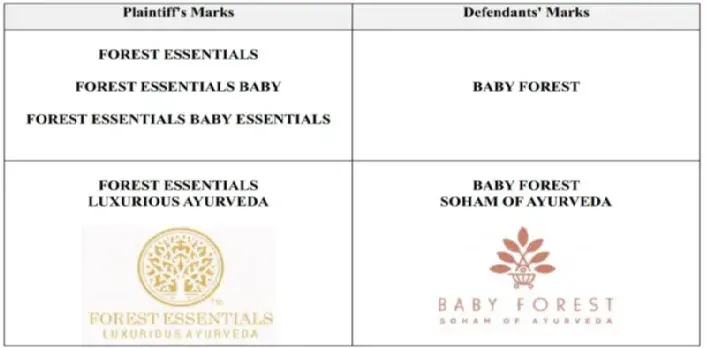
- Plaintiff’s Arguments:
- Prior user and goodwill:
The Plaintiff has been in the ayurvedic skincare industry since the year 2000 and enjoys immense goodwill and reputation for its mark FOREST ESSENTIALS, be it through its sales turnover, presence pan India and outside, advertising expenditure, presence in multiple hotels, and others.
The Defendants changed their trade name to ‘Baby Forest Ayurveda Private Limited’ in 2023, and earliest invoice with this name mentioned is of July 2023. Also, this invoice does not mention the mark BABY FOREST anywhere. These changes show that the Defendant tried to come as close as possible to the Plaintiff, to ride on their goodwill. - Trademark Registrations:
The Plaintiff has trademark registrations for both word and logo marks for FOREST ESSENTIALS in multiple classes, such as class 3, 5, 9 10, 16, 20, 21, 25, 29, 30, 31, 32, 33, 35,41 and 42. The same provides them with statutory, exclusive rights.
- Prior in market for baby products:
The Plaintiff has continuously sold its Mother and Baby care products since 2006 under its marks ‘FOREST ESSENTIALS BABY ESSENTIALS’ and ‘FOREST ESSENTIALS BABY’. For its baby care range of products, the Plaintiff claims significant annual sales of approximately Rs. 15 crores as well.
- Consumer Confusion:
The Plaintiff claimed that the similarities between the two marks are causing customers to think Baby Forest is related to the Plaintiff’s brand. Against this averment, certain emails, social media comments, and Google search results were shown by the Plaintiff.
- Contradictory pleas by Defendant:
The Defendants in one of their oppositions against the Plaintiff application for the mark FOREST ESSENTIALS BABY, had taken the stand that the Plaintiff’s mark was deceptive and detrimental to the Defendant’s. Therefore, the Defendants had in a way admitted that there is confusion between the two marks.
- Dishonest intent behind adoption of this mark:
In addition to adopting the tradename and similar trademarks, a similar ‘Tree’ logo, proves Defendants malicious intent in coming as close as possible to the Plaintiff, to ride on its goodwill and reputation.
- Initial interest confusion:
The trade channels of both products are similar, Defendant has a store in same mall where the Plaintiff has a store, products are identical and have a common class of consumers, hence there is initial interest confusion.
- Prior user and goodwill:
- Defendant’s arguments:
- Trademark Registrations for Forest Essentials Baby was an afterthought:
Only after the Court refused to grant an ex-parte interim injunction to the Plaintiff, they filed multiple applications for registration of the mark “Forest Essentials Baby” and “Forest Essentials- Baby Essentials”. The same demonstrates that these marks were not considered as trademarks earlier.The Defendants were granted registration of the mark ‘BABY FOREST’ on January 28, 2021 in Class 3 under No. 4549589 w.e.f. June 30, 2020, without any opposition from the Plaintiff. Subsequently, the registration of the domain name ‘babyforest.in’ was done in July 2020 and the Defendants launched their products in August 2022. Much later, on June 16, 2023, the Plaintiff sent a legal notice to the Defendants, which had no mention of the marks ‘Forest Essentials Baby’ or ‘Forest Essentials- Baby Essentials’.
- Generic Nature of the word “Forest”:
The Defendants contend that the term “Forest” is a dictionary word, and it cannot be monopolized by any single entity. Further, the word “Forest” in itself is descriptive and widely used in various contexts, making it ineligible for exclusive trademark protection. In fact, there are over 100 registrations in class 3, containing the mark FOREST in it, showing that it is commonly used in cosmetic and skin care products.
- Distinctive Products and Branding:
Defendants emphasized that their product line focused solely on baby care, was distinctly different from the broader range of products offered by the Plaintiff under the mark “Forest Essential”. It was also contended that the range of products offered by the Defendants was also wider than what the Plaintiff offered under its baby care range. Defendants further claims that the packaging, trade dress, branding, target market and even the adoption of the impugned ‘Tree’ logo for their products were sufficiently different than that of the Plaintiffs’, thus establishing the lack of confusion between the consumers of both parties. The difference between the Plaintiff and Defendants’ tree logo is as under:
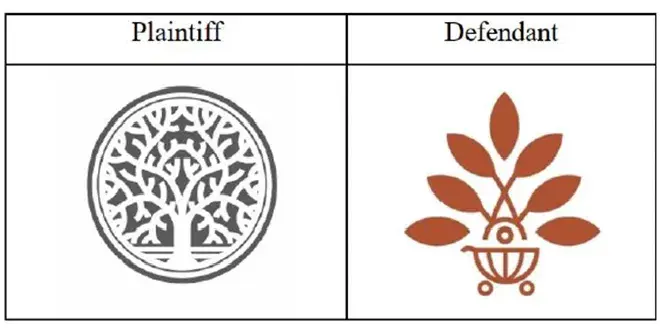
- Registration of Plaintiff’s Marks:
Defendant contends that the Plaintiff has always used ‘Forest’ and ‘Essentials’ together, and does not have a separate registration for the word ‘Forest’ under Section 17(2) of the Trade Marks Act, 1999.
- Trademark Registrations for Forest Essentials Baby was an afterthought:
Judgement
The Hon’ble High Court of Delhi, while dismissing the application seeking interim injunction restraining the Defendants from using the mark “Baby Forest” or any other mark identical or deceptively similar to the Plaintiff’s mark “Forest Essentials”, made the following observations vide judgment dated May 21, 2024:
- The Plaintiff never sought registration of the marks FOREST ESSENTIAL BABY and FOREST ESSENTIALS-BABY
ESSENTIALS, even though they have claimed use of these marks from 2006. The fact that after ex-parte interim injunction was refused, the Plaintiff applied for these registrations, shows that the Plaintiff was not trading under the said marks and the word ‘Baby’ and ‘Baby Essentials’ was merely used as a descriptive term along with their main house mark ‘FOREST ESSENTIALS’. The said house mark is also the main mark on which the Plaintiff’s goodwill and reputation hinges.
- Plaintiff cannot claim dominance over a generic term:
The Court ruled that the word “Forest” is generic and cannot be claimed exclusively by the Plaintiff without specific registration of part of the mark FOREST under Section 17(2) of the Trademark Act, 1999.The Court referred to the decision of Vardhman Buildtech Pvt. Ltd. v. Vardhman Properties Ltd. 2016 SCC OnLine Del 4738, wherein it was held that registration does not confer exclusive rights in part of the mark.Besides, the existence of other FOREST formative trademarks, some which exist even prior to the user of the Plaintiff shows that Plaintiff cannot claim monopoly over it.
- Anti-dissection rule: The Court noted that in its reply to the Examination
Report for the mark FOREST ESSENTIALS the Plaintiff had taken a basic stand that, uniqueness of their mark is in using the word “Forest” and “Essentials” together. Therefore, when this unique combination is the one that has achieved the reputation, the rule of anti-dissection will prevail, which prevents exclusive rights over a part of the mark. The court noted that while the combination may be distinctive, the individual components (“Forest” and “Essentials”) are not inherently protectable in isolation.
- Average intelligence and imperfect recollection test:
The Court cited the test of a ‘customer of average intelligence and imperfect recollection’ (originally articulated in Corn Products Refining Co. v. Shangrila Food Products Ltd., 1959 SCC OnLine SC 11, by the Hon’ble Supreme Court). When considering brand choice, it is essential to consider the category of goods, their price range, and the accessibility of relevant information through the internet and social media platforms, which can help clarify and influence brand preferences.The Court held that with the advent of time and rapid increase in technology and resources, it is not uncommon for a customer of average intelligence and imperfect recollection to cross check the origin of a product and the particulars of a brand by taking advantage of the substantial data and resources available to the consumer through the access of the internet. When it comes to baby care products, purchasers, typically parents, exercise extra caution in selecting the right product or brand for their babies.
- Evidence of consumer confusion:
The evidence presented by the Plaintiff was deemed insufficient to establish significant consumer confusion. The Court held that the instances of alleged confusion, such as social media posts and customer inquiries, did not demonstrate widespread or likelihood of confusion among the relevant consumer base. The court observed that minor confusion among customers does not warrant a complete injunction against the Defendant’s mark.
- Pianotist Test
The Court cited the “Pianotist test” established by Parker J. in Pianotist Co. Application, (1906) 23 RPC 774, as a fundamental framework for assessing infringement, deception, confusion, association. It is underscored that the test itself adumbrated by Parker J includes assessing customer behavior and surrounding circumstances. The ‘Pianotist test’ includes “you must consider the nature and kind of customer who would be likely to buy those goods” and “in fact you must consider all these surrounding circumstances….” This test emphasizes the importance of considering customer behavior and surrounding circumstances, including the nature and type of customers likely to purchase the goods, and considering all relevant factors.
- The Court ruled that the Plaintiff’s claim of ownership over the trademarks “Forest Essentials Baby” and “Forest Essentials Baby Essentials” was not convincing, at least at the prima facie stage.
- Goodwill and Reputation:
The Court admitted that Plaintiff’s documents primarily demonstrated their reputation and goodwill associated with their main brand name “Forest Essentials” range aimed at adults, with minimal references to baby care products. Plaintiff’s registrations were confined solely to the house mark “Forest Essentials.” Furthermore, just because the Plaintiff had higher annual turnover, it did not justify displacing a registered mark BABY FOREST when they themselves do not have any registration for FOREST ESSENTIAL BABY.
Based on these findings, the Learned Single Judge denied the interim injunction sought by the Plaintiff.
Conclusion and Author’s note
While Forest Essentials has challenged this order and the Learned Division Bench has so far given a prima facie view that the learned Singh Judge was wrong in interpreting the doctrine of initial interest confusion, this interim order comes as a critical precedent for brand owners standing at the Defendant’s podium and facing allegations of infringement/passing off.
The order thinks of a revised form of ‘consumer with average intelligence and imperfect recollection’, by placing this customer in the age of the internet. By doing so, the learned Single Judge has in a way, changed the ‘average consumer’ to an “informed/aware consumer” and turned the trajectory of adjudicating trademark matters.
While the Court has acknowledged that a brand encompasses multiple elements, including the word mark, device mark, trade dress, get-up, layouts, artistic work, online and social media presence, positioning, price point, and target consumer, the same effects the likelihood of confusion, disruption, and likelihood of association. The Court should therefore assess these scenarios in a comprehensive context rather than in isolation.
However, the Single Judge’s ruling also underscores the necessity for brands to carefully consider their trademark strategies and to ensure robust legal protection for their marks. Few things to consider in this regard would be:
- Conducting trade mark search prior to applying for a mark to find out if you are in conflict with an existing mark. For this, it is important that the branding/marketing team and in sync with the legal team.
- Being mindful of what one is submitting in their reply to examination reports before the Trade Mark Registry. Often, to expedite the examination process of a trademark application, brands may submit that the mark is to be seen as a whole or give disclaimers to part of the mark. The same then binds you in future and may even hinder you from taking legal action of infringement/passing off.
- Keeping a watch of marks that are advertised in the Trade Mark Journal, so that conflicting marks can be opposed within the statutory period of 4 months, instead of letting them pass to registration.
- File registrations for part of their mark, in addition to the entire mark, if part of a trademark is capable of being registered separately.
[1] CS(COMM) 523/2023
The Cost of Counterfeit: How Burberry Defended its Brand Identity

Introduction
As per recent reports, luxury goods retail face $30 billion annual loss due to counterfeiting which is diluting their brand identity.[1] The latest report of Authentication Solution Provider’s Association (ASPA) reveals that counterfeiting activities significantly impact various industries, including luxury fashion, where fake products are prevalent. Consumers and retailers in major Indian cities estimate that 25-30% of goods in the market are counterfeit, with luxury items being highly susceptible due to high consumer demand and price sensitivity. [2]
Maintaining trade mark integrity is crucial for luxury businesses as it not only meets legal requirements but also serves as a fundamental element of brand identity and customer confidence. The significance of this idea is highlighted by the recent ruling rendered by the Hon’ble Delhi High Court in Burberry Limited v. Petrol Perfume[3]. The Hon’ble Court’s decision not only brought attention to the complexities of trade mark law but also established a standard for how cases of a similar nature might be handled in the future, particularly in the luxury goods industry.
The Hon’ble Court’s decision is crucial because it serves as a key reminder to businesses about the moral and legal ramifications of managing their brands and the potentially dangerous effects of crossing intellectual property lines. This article explores the specifics of the Hon’ble Court’s rulings, the legal defences put up by each party, and the wider ramifications for trade mark enforcement in the very competitive luxury market.
About the Parties:
- Burberry, a globally renowned and premium fashion brand headquartered in the UK and operating in India through its subsidiary, Burberry India Ltd., filed a lawsuit against M/s Petrol Perfumes, claiming that:
- The latter had stolen and passed-off their highly reputed and well-known trade marks “MY BURBERY” (
 ) and “MR. BURBERRY” (
) and “MR. BURBERRY” ( ) adopted since 2014 and 2016 respectively globally.
) adopted since 2014 and 2016 respectively globally. - Burberry also claimed that M/s Petrol Perfumes was using their distinctive trade dress to infringe on their marks.
- Burberry argued that this diminished the unique quality and prestige of their well-known trade marks in addition to confusing customers.
- The latter had stolen and passed-off their highly reputed and well-known trade marks “MY BURBERY” (
- M/s Petrol Perfume is an MSME incorporated on February 01, 2017 and deals in manufacturing and selling perfumes and deodorants.
Facts of the Case:
The Plaintiff, Burberry Limited, owns several registered trade marks such as BURBERRY, BURBERRY EQUESTRIAN KNIGHT Logo, CHECK device, and various BURBERRY formative trademarks/ labels and is known for their logo ( ).The Plaintiff is engaged in the business of manufacturing, distribution and sale of a wide range of products including apparels, garments, glasses, footwear and fragrances. The Plaintiff and has been using their trade marks continuously, exclusively, and uninterruptedly since their adoption on their websites and third-party websites. The products under “MY BURBERY” and “MR. BURBERRY” are a commercial success and one of the most renowned fragrances of the Plaintiff however no registration application is filed for those two marks.
).The Plaintiff is engaged in the business of manufacturing, distribution and sale of a wide range of products including apparels, garments, glasses, footwear and fragrances. The Plaintiff and has been using their trade marks continuously, exclusively, and uninterruptedly since their adoption on their websites and third-party websites. The products under “MY BURBERY” and “MR. BURBERRY” are a commercial success and one of the most renowned fragrances of the Plaintiff however no registration application is filed for those two marks.
- Similar Marks:
The Defendant, M/s Petrol Perfume began manufacturing and selling fragrances under the marks MR. PETROL ( ) and MY PETROL (
) and MY PETROL ( ) which were deceptively similar to the Plaintiff’s marks “MY BURBERY” (
) which were deceptively similar to the Plaintiff’s marks “MY BURBERY” ( ) and “MR. BURBERRY” (
) and “MR. BURBERRY” ( ).
).
Demo MR. PETROL MY PETROL 

Application No. 4451115 Application No. 4451114 GOODS/SERVICES: Perfume, Body Spray & Deodorants Included In Class 03. GOODS/SERVICES: Perfume, Body Spray & Deodorants Included In Class 03. - Identical trade dress:
Also, the Defendant, M/s Petrol Perfume adopted an identical trade dress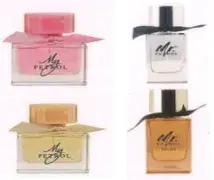 to that of the Plaintiff
to that of the Plaintiff 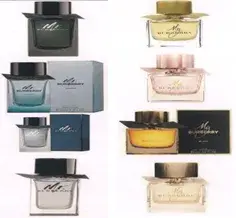 , i.e., identical fonts, color combination, overall look etc. and were selling them under the impugned marks.
, i.e., identical fonts, color combination, overall look etc. and were selling them under the impugned marks. - Identical goods:
The Defendant used identical marks and trade dress in manufacturing and selling identical goods resulting in high probability of confusion in the market and dilution of the Plaintiff’s marks. - Habitual and Serial Infringer:
The Defendant adopted a modus operandi of counterfeiting products and imitating marks/ trade dress of several popular brands which have already attained recognition and reputation in the market. Such counterfeiting activity has been restrained by Hon’ble Courts on prior occasions as well.The Plaintiff thus filed a lawsuit against M/s Petrol Perfumes, seeking injunctive relief and damages for trade mark infringement, unfair competition and dilution of brand identity.
Contentions of the Parties:
- Submissions made by the Counsel for the Plaintiff:
- Owing to the huge amount spent in advertising and campaigns, the Plaintiff’s marks “MY BURBERRY”
 and “MR. BURBERRY”
and “MR. BURBERRY”  had gained significant goodwill and reputation.
had gained significant goodwill and reputation. - Further, the Plaintiff contended that M/s Petrol Perfume’s use of similar check patterns and similar packaging was designed to confuse consumers and mislead them into believing that they were genuinely purchasing Burberry’s products.
- Such actions infringed upon Burberry’s trade mark and also damaged brand reputation and diluted their marks.
- Submissions made by the Counsel for the Defendant:
- The Defendants claimed that their marks are registered and that Burberry marks are registered in Class 3 however no application has been filed for “MY BURBERRY” and “MR. BURBERRY.” Hence, they are not under the ambit of infringement.
- They also contended that the dominant part of their marks are not similar to that of the Plaintiff.
- Further, they contended that since they cater to different category of the consumers (as the pricing for their products is significantly low), there would be no confusion or deception in the minds of the public.
- The marks of the Defendants have been in the market since 2019, but no action has been taken by the Plaintiff since then.
Issues Involved:
- Whether M/s Petrol Perfumes use of similar packaging constituted trade mark infringement?
- Whether actions of M/s Petrol Perfumes amounted to unfair competition?
- Whether there was any dilution of Burberry Limited’s distinctive trade mark and brand value due to M/s Petrol Perfumes’ actions?
Decision of the Hon’ble Court:
The Hon’ble High Court of Delhi did a comparative analysis of the parties’ trade marks and trade dresses to arrive at a decision, which is tabulated below:
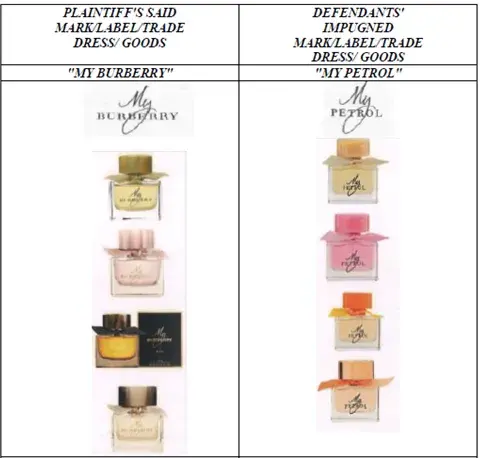
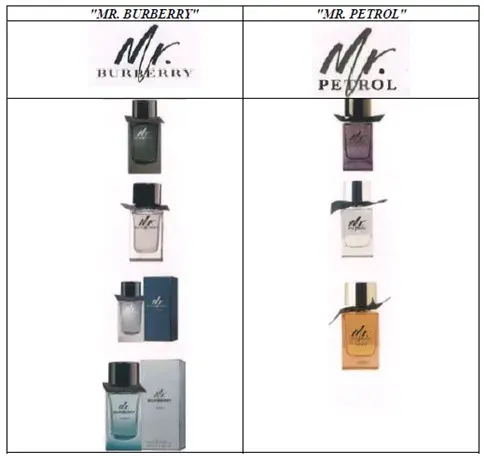
The Hon’ble Court held that even though the marks were not similar on the face of it, but the similar trade dress amounted to counterfeiting and since the Defendants were using the impugned marks for selling similar products, i.e., fragrances, they certainly did not have a bona fide intention and were deliberately attempting to harm the Plaintiff’s established goodwill and reputation.
The Hon’ble Delhi High Court also opined that the typography and the almost identical trade dress created an unmistakable impression of counterfeiting.
More importantly, the Defendant’s contention that the Plaintiff could not press for injunction against infringement as their marks were registered was rejected by the Hon’ble Court by citing the decision of the Hon’ble Supreme Court in the case of S. Syed Mohideen v. P. Sulochana Bai[4],wherein the Hon’ble Court held that “passing off is a broader remedy than infringement” and can be pursued even if the Defendant’s impugned mark is registered.
In the present case as well, all the three key elements of passing off were met:
- Plaintiff had formulated a reputation in their marks,
- The Defendant had a malafide intention to harm the reputation of the Plaintiff
- The Plaintiff would incur irreparable loss if the Defendant was not restricted.
Therefore, the Hon’ble Court granted an ad-interim injunction in favour of the Plaintiff against, misrepresentation, passing-off, and counterfeiting by the Defendant and accordingly restrained the Defendant from using, selling, manufacturing, marketing, importing, exporting or dealing in any manner in the physical or online market place, under the impugned marks.
Conclusion:
The Hon’ble Delhi High Court’s decision to rule in the Burberry’s favour against Petrol Perfumes establishes a significant legal precedent for the protection of trade mark rights, especially in the market of luxury brands. This case highlights the value of the brand integrity and demonstrates the judiciary’s dedication to safeguarding well-known brands from potential confusion brought on by competitors with similar names. This decision also acts as a cautionary tale to prospective competitors about the gravity of trade mark infringement.
Gautami Goel (Former Intern) & Asmita Kaur (Assessment Intern) at S.S. Rana & Co. has assisted in the research of this Article.
[1]Traditional methods insufficient to control counterfeiting in luxury retail market: Qila https://economictimes.indiatimes.com/industry/cons-products/fashion-/-cosmetics-/-jewellery/traditional-methods-insufficient-to-control-counterfeiting-in-luxury-retail-market-qila/articleshow/110297876.cms?from=mdr (last accessed on May 27, 2024)
[2] 25-30% of the market in India is counterfeit: ASPA-CRISIL report https://www.printweek.in/news/25-30-of-the-market-in-india-is-counterfeit-aspa-crisil-report–57137 (last accessed on May 27, 2024)
[3] 2024 SCC OnLine Del 2801
[4] (2016) 2 SCC 683
Related Posts
The new age Infringers: Delhi High Court tackles online counterfeits
MYANMAR PATENT LAW CAME INTO FORCE ON MAY 31, 2024

CONTENT :
Myanmar’s Patent law namely, “Pyidaungsu Hluttaw Law No. 7/2019” (enacted on March 11, 2019) has come into force vide Notification Number 160/2024 as issued by the State Administration Council of the Republic of the Union of Myanmar on May 31, 2024[i]. It is relevant to mention here that before the enactment of the Patent Law, the patents in Myanmar were being recorded as a Declaration of Ownership (DOO) at the Registry of Deeds & Assurances. However, it is to be noted here that patents which have already been recorded as a Declaration of Ownership (DOO) at the Registry of Deeds & Assurances cannot be re-registered under the new Patents Act due to the lack of novelty.
Key takeaways from Myanmar’s New Patent Law:
- The Intellectual Property Office (IPD) established under the Ministry of Commerce, Myanmar shall soon start accepting patent applications for inventions that satisfy patentability criteria of:
(i) novelty;
(ii) inventive step, and
(iii) industrial applicability
- The patent law also extends protection to minor inventions (a new form of a product or a new structure of the parts of a product, or a part of a product that increases its utility or performance) that are novel and have industrial applicability.
- The IPD shall not accept any patent application relating to pharmaceutical inventions until January 01, 2033 (in accordance with the policy of TRIPS council as specified in the Act).
- A patent application entering Myanmar claiming priority from a basic application filed in a member country (member country of the Paris Convention and the World Trade Organization) can be filed within 12 months from the date of filing of the priority application. This will ease the process of claiming priority of foreign patent applications filed in the member states as mentioned in the Act- “If a patent applicant who has applied in a Member State of the Paris Convention or in a Member State of the Word Trade Organization or any transferee of said applicant applies to the Department for registration of the same invention within one year from date of initial application” (Section 43 of the Act). However, it is pertinent to note here that Myanmar till now is neither a contracting state of PCT[ii] nor a member of the Paris Convention[iii].
- A patent application for an invention may be filed for a product or a production process (solving a particular problem in a technical field).
- The invention should satisfy the criteria of novelty, inventive step and industrial applicability.
- Non-patentable inventions include:
-
- Discoveries, scientific theories and mathematical calculations
- Business methods, pure computer programs, games
- Biological production processes mainly used for growing plants or rearing animals (except non-biological and microbiological production processes)
- Plants and organisms which include all organism and plant species, DNA, and biological materials found in nature (except man-made microbiological organisms)
- Surgical or treatment methods
- Inventions detrimental to public morale and order
- Inventions already known to the public and necessary chemicals.
- A patent application may be filed by a single or joint inventor(s), applicant (assignee, licensee or transferee), employer, or employee (under certain conditions).
- The patent application entering Myanmar from a member country (Paris Convention or WTO) within 12 months from a basic application filed in the member country shall claim priority to the basic application.
- Examination – Request for examination shall be filed within 36 months from the application filing or priority date. During the examination, applicant is allowed to amend the application within 60 days of such notice. The application is deemed to be withdrawn if the application is not amended with said period. However, the applicant may submit a request along with fees and explanation within 60 days from date of withdrawal to reinstate the application.
- Opposition – A request for opposition along with reasons can be filed against grant of the patent within 90 days from the date of grant. The grounds for opposition are lack of patentability (novelty inventive step & industrial applicability), excluded subject matters, absence of best method, insufficiency of disclosure, and lack of clarity & conciseness.
- Grant/ Refusal – The Registrar can either grant or refuse a patent application by reviewing the Examiner’s remarks and record the reasons for any such action.
Conclusion
The enforcement of Patent law in Myanmar marks a significant leap forward to the country’s legal and economic landscape. This not only aligns Myanmar with the international IP standards, but also fosters an environment conducive to creativity, innovation, and investment. With stronger patent regime, Myanmar is bound to attract global business and gain a competitive edge on a global standpoint. An established and structured legal framework in patents shall indeed play a crucial role in fostering economic growth of Myanmar.
[i] https://www.moi.gov.mm/moi%3Aeng/news/14129
[ii] https://www.wipo.int/pct/en/pct_contracting_states.html
[iii] https://www.wipo.int/wipolex/en/treaties/ShowResults?search_what=C&treaty_id=2


